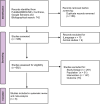Efficacy and safety of fezolinetant, a neurokinin-3 antagonist, in treating vasomotor symptoms in postmenopausal women: A systematic review and meta-analysis
- PMID: 38115258
- PMCID: PMC10727556
- DOI: 10.1097/MD.0000000000036592
Efficacy and safety of fezolinetant, a neurokinin-3 antagonist, in treating vasomotor symptoms in postmenopausal women: A systematic review and meta-analysis
Abstract
Background: Menopause causes a variety of symptoms such as hot flashes and night sweats. While menopausal hormonal therapy has been used for managing postmenopausal vasomotor symptoms (VMS) for quite a while, it has a considerably poor safety profile.
Objective: To review and analyze existing data to evaluate the efficacy of the neurokinin-3 antagonist, fezolinetant, in treating postmenopausal VMS and to assess its safety profile.
Methods: A thorough literature search was performed on PubMed, Cochrane Library, and Google Scholar in compliance with Preferred Reporting Items for Systematic Reviews and Meta-Analysis 2020, to find publications on the efficacy of fezolinetant for postmenopausal VMS. Changes in the frequency and severity scores of moderate/severe VMS and changes in the Hot Flash-Related Daily Interference Scale (HFRDIS), Greene Climacteric Scale (GCS), and Menopause-Specific Quality of Life (MENQoL) were the efficacy outcomes. Adverse events, drug-related treatment-emergent adverse effects (TEAEs), drug-related dropouts, hepatotoxicity, endometrial hyperplasia or tumor, and uterine bleeding were all safety outcomes. We used Review Manager 5.4 for pooling risk ratios (RRs) and mean differences (MDs) for dichotomous and continuous outcomes, respectively. A P value of < .05 was considered significant.
Results: There was a significant reduction in mean daily VMS frequency at weeks 4 and 12 (MD, -2.36; 95% confidence interval [CI], -2.85 to -1.87; P < .00001, for week 12) and also a significant decrease in VMS severity scores in the treatment group. Furthermore, improvements in MENQoL, HFRDIS, and GCS scores were observed. There was no significant difference in adverse events while drug-related TEAEs (RR, 1.21; 95% CI, 0.90-1.63; P = .21) showed a slight increase with fezolinetant. Drug-related dropouts were again similar across the 2 groups. Uterine bleeding had a lower incidence while endometrial events and hepatotoxicity showed a statistically insignificant, increasing trend in the fezolinetant group.
Discussion and implications: Fezolinetant can be a treatment option for postmenopausal VMS but warns of a risk increase in endometrial hyperplasia or tumors. The heterogeneity in the data being analyzed, short follow-up period, and small sample size in most of the included randomized controlled trials were the greatest limitations, which must be considered in further research and safety profile exploration.
Copyright © 2023 the Author(s). Published by Wolters Kluwer Health, Inc.
Conflict of interest statement
The authors have no conflicts of interest to disclose.
Figures













Similar articles
-
Effect of the neurokinin 3 receptor antagonist fezolinetant on patient-reported outcomes in postmenopausal women with vasomotor symptoms: results of a randomized, placebo-controlled, double-blind, dose-ranging study (VESTA).Menopause. 2020 Dec;27(12):1350-1356. doi: 10.1097/GME.0000000000001621. Menopause. 2020. PMID: 32769757 Free PMC article. Clinical Trial.
-
Fezolinetant for the treatment of vasomotor symptoms associated with menopause: a meta-analysis.Climacteric. 2024 Jun;27(3):245-254. doi: 10.1080/13697137.2024.2334083. Epub 2024 Apr 15. Climacteric. 2024. PMID: 38619017 Review.
-
Efficacy and Safety of Fezolinetant in Moderate to Severe Vasomotor Symptoms Associated With Menopause: A Phase 3 RCT.J Clin Endocrinol Metab. 2023 Jul 14;108(8):1981-1997. doi: 10.1210/clinem/dgad058. J Clin Endocrinol Metab. 2023. PMID: 36734148 Free PMC article. Clinical Trial.
-
Fezolinetant impact on health-related quality of life for vasomotor symptoms due to the menopause: Pooled data from SKYLIGHT 1 and SKYLIGHT 2 randomised controlled trials.BJOG. 2024 Aug;131(9):1296-1305. doi: 10.1111/1471-0528.17773. Epub 2024 Feb 6. BJOG. 2024. PMID: 38320967 Clinical Trial.
-
Fezolinetant: A Potential Treatment for Moderate to Severe Vasomotor Symptoms of Menopause.touchREV Endocrinol. 2023 Nov;19(2):69-72. doi: 10.17925/EE.2023.19.2.13. Epub 2023 Jun 15. touchREV Endocrinol. 2023. PMID: 38187079 Free PMC article. Review.
References
-
- Nelson HD. Menopause. Lancet. 2008;371:760–70. - PubMed
-
- O'Reilly K, McDermid F, McInnes M, et al. . An exploration of women’s knowledge and experience of perimenopause and menopause: an integrative literature review. J Clin Nurs. 2023;32:4528–40. - PubMed
-
- Richard-Davis G, Weickert A, Christensen L, et al. . A review of African American women’s experiences in menopause. 2023;29:1331–7. - PubMed
-
- Ayers B, Smith M, Hellier J, et al. . Effectiveness of group and self-help cognitive behavior therapy in reducing problematic menopausal hot flushes and night sweats (MENOS 2): a randomized controlled trial. Menopause. 2012;19:749–59. - PubMed
Publication types
MeSH terms
Substances
LinkOut - more resources
Full Text Sources
Medical
Research Materials
Miscellaneous

